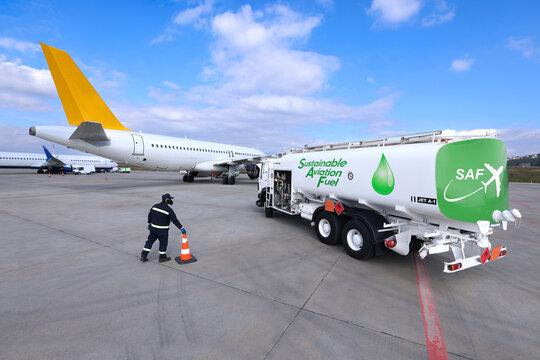Decarbonizing European Aviation: The Rise of SAF

Introduction
The Europe Sustainable Aviation Fuels (SAF) Market is accelerating as airlines, fuel producers, and policymakers work to decarbonize aviation without compromising connectivity and economic growth. SAF—produced from waste oils, agricultural residues, municipal solid waste, captured CO₂ with green hydrogen, and advanced feedstocks—can reduce lifecycle emissions by 60–90% compared to conventional Jet A-1, depending on pathway. Europe’s policy push, airport readiness, corporate demand for low-carbon travel, and emerging offtake agreements are converting pilot volumes into commercial supply. With blending mandates progressing and large-scale projects announced across Northwest Europe, the Mediterranean, and the Nordics, the region is evolving into a global hotspot for SAF technology deployment and market formation.
Market Drivers
Regulatory momentum is the foremost driver. EU-wide measures and national policies are establishing binding SAF blend targets at increasing levels over the next decade, creating predictable demand. Corporate climate commitments and Scope 3 reduction goals are prompting airlines and travel buyers to sign multi-year offtake deals, often with price premia via “book-and-claim” models. Airport-side handling capability and early fueling logistics at major hubs are reducing operational barriers, while airlines integrate SAF into routine flights to build familiarity. Technology diversification—HEFA, Alcohol-to-Jet (ATJ), Fischer-Tropsch from biogenic or waste feedstocks, and Power-to-Liquid (PtL) e-fuels—broadens supply options. Lastly, the post-pandemic rebound in air travel and the growth of short- and medium-haul networks keep pressure on airlines to decarbonize operationally rather than relying only on offsets.
Market Challenges
The primary constraint is cost. SAF remains materially more expensive than fossil jet fuel, with price gaps varying by pathway and feedstock availability. Limited sustainable feedstocks—particularly waste lipids—tighten supply, while sustainability criteria restrict land-use change and indirect emissions. Scale-up risks include permitting timelines, financing of first-of-a-kind plants, and competition for green hydrogen and renewable power for e-fuels. Logistics—segregated storage, blending infrastructure, and certification handling—add complexity and cost at smaller airports. Certification timelines for new pathways are rigorous, and drop-in blend limits (up to 50% today for most ASTM-approved fuels) cap near-term substitution. Airlines’ thin margins and fuel price volatility make long-term price premia challenging without policy support or customer co-funding.
Market Opportunities
Europe can anchor a full SAF value chain. Waste-to-jet plants sited near large urban centers can utilize municipal waste, while agricultural residues in Central and Southern Europe can feed FT or ATJ pathways. The Nordics and Iberia offer strong renewable power potential, positioning them for PtL e-fuel projects that synthesize hydrocarbons from captured CO₂ and green hydrogen. Long-term offtake contracts, carbon contracts for difference, and production incentives unlock bankability for new facilities. Hard-to-abate long-haul routes are prime candidates for early SAF deployment, with corporate travel programs underwriting cost gaps. Co-processing in existing refineries provides a pragmatic bridge to higher volumes, while new dedicated biorefineries de-risk longer-term supply. Airports can differentiate by becoming “SAF hubs,” offering guaranteed availability, digital tracking, and transparent emissions accounting for airline and corporate reporting.
Regional Insights
Northwest Europe—particularly the Netherlands, Germany, the UK, and France—leads with policy instruments, refinery conversion projects, and strong airline demand. The Nordics combine ambitious national targets with renewable power depth, enabling both HEFA and e-fuel initiatives. Spain and Portugal are emerging as SAF growth markets due to solar and wind resources supporting green hydrogen and PtL, alongside access to agricultural residues. Italy and Central/Eastern Europe contribute feedstocks and logistics corridors, with growing interest in converting existing refining assets. Smaller states with major hub airports focus on import logistics and book-and-claim systems that allow decoupled physical delivery and environmental attribute allocation to airlines and corporates.
Future Outlook
The market will evolve along three vectors: scale, diversification, and digitalization. Scale will come from multi-hundred-kiloton plants, refinery co-processing expansions, and cross-border pipelines of certified SAF. Diversification will broaden from HEFA toward FT-biomass and PtL e-fuels as renewable power and electrolyzer capacity expand and as feedstock sustainability thresholds tighten. Digitalization—trusted registries, book-and-claim platforms, and mass-balance accounting—will enable transparent chain-of-custody and eliminate double counting, unlocking corporate funding. Expect blend targets to ratchet upward, with airports standardizing storage and blending. As technology learning curves and renewable power costs decline, the price premium should compress, especially for e-fuels produced at scale with low-cost green electricity. By the early 2030s, Europe is positioned to reach meaningful double-digit SAF shares on key corridors, with long-haul routes prioritizing high-blend operations.
Conclusion
Europe’s Sustainable Aviation Fuels Market is shifting from pilots to portfolio strategy. Strong policies, airline and corporate demand, and a maturing project pipeline are creating the conditions for industrial scale-up. Costs, feedstock constraints, and infrastructure complexity remain non-trivial, but diversified pathways, innovative financing, and airport-led operational readiness indicate durable momentum. Players that secure reliable feedstocks or green power, lock in long-term offtakes, and build credible sustainability assurance will lead. As SAF volumes rise and premiums narrow, Europe’s aviation sector will have a pragmatic, drop-in solution to decarbonize flight while broader aircraft and airspace efficiencies continue in parallel.
- Art
- Causes
- Crafts
- Dance
- Drinks
- Film
- Fitness
- Food
- Juegos
- Gardening
- Health
- Home
- Literature
- Music
- Networking
- Other
- Party
- Religion
- Shopping
- Sports
- Theater
- Wellness
